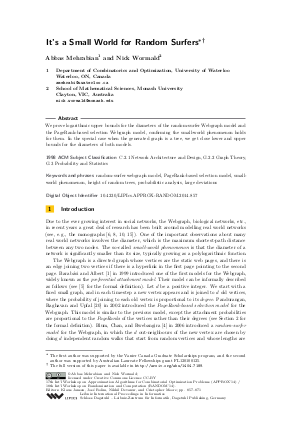It’s a Small World for Random Surfers
Authors Abbas Mehrabian, Nick Wormald
-
Part of:
Volume:
Approximation, Randomization, and Combinatorial Optimization. Algorithms and Techniques (APPROX/RANDOM 2014)
Part of: Series: Leibniz International Proceedings in Informatics (LIPIcs)
Part of: Conference: International Conference on Randomization and Computation (RANDOM)
Part of: Conference: International Conference on Approximation Algorithms for Combinatorial Optimization Problems (APPROX) - License:
 Creative Commons Attribution 3.0 Unported license
Creative Commons Attribution 3.0 Unported license
- Publication Date: 2014-09-04
File

PDF
LIPIcs.APPROX-RANDOM.2014.857.pdf
- Filesize: 0.5 MB
- 15 pages
Document Identifiers
Subject Classification
Keywords
- random-surfer webgraph model
- PageRank-based selection model
- smallworld phenomenon
- height of random trees
- probabilistic analysis
- large deviations
Metrics
- Access Statistics
-
Total Accesses (updated on a weekly basis)
0PDF Downloads0Metadata Views
Abstract
We prove logarithmic upper bounds for the diameters of the random-surfer Webgraph model and the PageRank-based selection Webgraph model, confirming the small-world phenomenon holds for them. In the special case when the generated graph is a tree, we get close lower and upper bounds for the diameters of both models.
Cite As Get BibTex
Abbas Mehrabian and Nick Wormald. It’s a Small World for Random Surfers. In Approximation, Randomization, and Combinatorial Optimization. Algorithms and Techniques (APPROX/RANDOM 2014). Leibniz International Proceedings in Informatics (LIPIcs), Volume 28, pp. 857-871, Schloss Dagstuhl – Leibniz-Zentrum für Informatik (2014)
https://doi.org/10.4230/LIPIcs.APPROX-RANDOM.2014.857
BibTex
@InProceedings{mehrabian_et_al:LIPIcs.APPROX-RANDOM.2014.857,
author = {Mehrabian, Abbas and Wormald, Nick},
title = {{It’s a Small World for Random Surfers}},
booktitle = {Approximation, Randomization, and Combinatorial Optimization. Algorithms and Techniques (APPROX/RANDOM 2014)},
pages = {857--871},
series = {Leibniz International Proceedings in Informatics (LIPIcs)},
ISBN = {978-3-939897-74-3},
ISSN = {1868-8969},
year = {2014},
volume = {28},
editor = {Jansen, Klaus and Rolim, Jos\'{e} and Devanur, Nikhil R. and Moore, Cristopher},
publisher = {Schloss Dagstuhl -- Leibniz-Zentrum f{\"u}r Informatik},
address = {Dagstuhl, Germany},
URL = {https://drops.dagstuhl.de/entities/document/10.4230/LIPIcs.APPROX-RANDOM.2014.857},
URN = {urn:nbn:de:0030-drops-47437},
doi = {10.4230/LIPIcs.APPROX-RANDOM.2014.857},
annote = {Keywords: random-surfer webgraph model, PageRank-based selection model, smallworld phenomenon, height of random trees, probabilistic analysis, large deviations}
}
Author Details
References
-
A.-L. Barabási and R. Albert. Emergence of scaling in random networks. Science, 286(5439):509-512, 1999.

- S. Bhamidi. Universal techniques to analyze preferential attachment trees: global and local analysis. preprint, available via http://www.unc.edu/~bhamidi/, 2007.
-
G. Bianconi and A.-L. Barabási. Competition and multiscaling in evolving networks. Europhys. Lett., 54(4):436-442, 2001.

-
A. Blum, T.-H. H. Chan, and M. R. Rwebangira. A random-surfer web-graph model. In Proc. of 8th Workshop on Algorithm Engineering and Experiments and 3rd Workshop on Analytic Algorithmics and Combinatorics, pages 238-246, 2006.

-
B. Bollobás and O. Riordan. The diameter of a scale-free random graph. Combinatorica, 24(1):5-34, January 2004.

-
A. Bonato. A course on the web graph, volume 89 of Graduate Studies in Mathematics. American Mathematical Society, Providence, RI, 2008.

-
N. Broutin and L. Devroye. Large deviations for the weighted height of an extended class of trees. Algorithmica, 46(3-4):271-297, 2006.

-
D. Chakrabarti and C. Faloutsos. Graph Mining: Laws, Tools, and Case Studies. Synthesis Lectures on Data Mining and Knowledge Discovery. Morgan & Claypool Publishers, 2012.

-
P. Chebolu and P. Melsted. Pagerank and the random surfer model. In Proceedings of the 19th annual ACM-SIAM symposium on Discrete algorithms, SODA'08, pages 1010-1018, Philadelphia, PA, USA, 2008.

-
F. Chung and L. Lu. Complex graphs and networks, volume 107 of CBMS Regional Conference Series in Mathematics. Published for the Conference Board of the Mathematical Sciences, Washington, DC, 2006.

-
A. Dembo and O. Zeitouni. Large deviations techniques and applications, volume 38 of Stochastic Modelling and Applied Probability. Springer-Verlag, Berlin, 2010. Corrected reprint of the second (1998) edition.

-
L. Devroye, O. Fawzi, and N. Fraiman. Depth properties of scaled attachment random recursive trees. Random Structures Algorithms, 41(1):66-98, 2012.

-
S. Dommers, R. van der Hofstad, and G. Hooghiemstra. Diameters in preferential attachment models. Journal of Statistical Physics, 139(1):72-107, 2010.

-
E. Drinea, A. Frieze, and M. Mitzenmacher. Balls and bins models with feedback. In Proceedings of the thirteenth annual ACM-SIAM symposium on Discrete algorithms, SODA'02, pages 308-315, Philadelphia, PA, USA, 2002.

-
R. Durrett. Random graph dynamics. Cambridge Series in Statistical and Probabilistic Mathematics. Cambridge University Press, Cambridge, 2010.

-
G. Ergün and G.J. Rodgers. Growing random networks with fitness. Physica A: Statistical Mechanics and its Applications, 303(1-2):261-272, 2002.

-
P. L. Krapivsky and S. Redner. Organization of growing random networks. Phys. Rev. E, 63:066123, May 2001.

-
J. Leskovec, J. Kleinberg, and C. Faloutsos. Graph evolution: Densification and shrinking diameters. ACM Trans. Knowl. Discov. Data, 1(1), March 2007.

-
L. Page, S. Brin, R. Motwani, and T. Winograd. The pagerank citation ranking: Bringing order to the web. Technical Report 1999-66, Stanford InfoLab, 1999.

-
G. Pandurangan, P. Raghavan, and E. Upfal. Using pagerank to characterize web structure. In Proceedings of the 8th Annual International Conference on Computing and Combinatorics, COCOON'02, pages 330-339, London, UK, UK, 2002.

-
G. Pandurangan, P. Raghavan, and E. Upfal. Using pagerank to characterize web structure. Internet Mathematics, 3(1):1-20, 2006.

-
B. Pittel. Note on the heights of random recursive trees and random m-ary search trees. Random Structures and Algorithms, 5(2):337-347, 1994.

